Eye examination
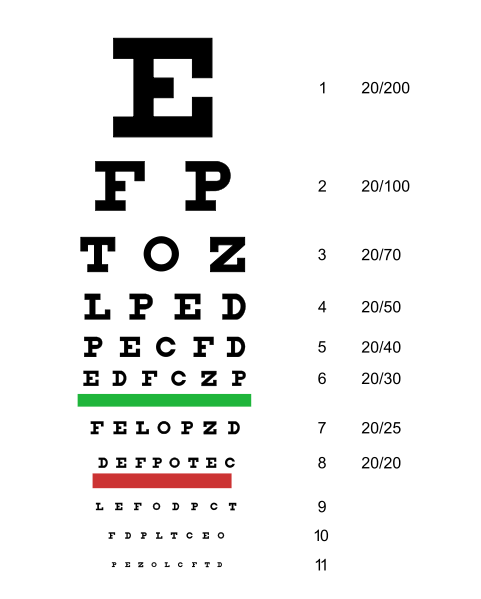
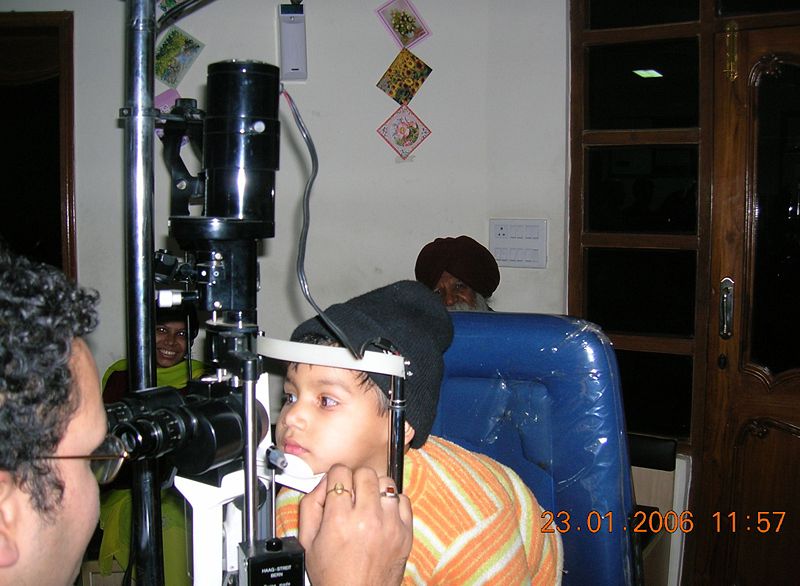
|
WikiDoc Resources for Eye examination |
|
Articles |
|---|
|
Most recent articles on Eye examination Most cited articles on Eye examination |
|
Media |
|
Powerpoint slides on Eye examination |
|
Evidence Based Medicine |
|
Clinical Trials |
|
Ongoing Trials on Eye examination at Clinical Trials.gov Trial results on Eye examination Clinical Trials on Eye examination at Google
|
|
Guidelines / Policies / Govt |
|
US National Guidelines Clearinghouse on Eye examination NICE Guidance on Eye examination
|
|
Books |
|
News |
|
Commentary |
|
Definitions |
|
Patient Resources / Community |
|
Patient resources on Eye examination Discussion groups on Eye examination Patient Handouts on Eye examination Directions to Hospitals Treating Eye examination Risk calculators and risk factors for Eye examination
|
|
Healthcare Provider Resources |
|
Causes & Risk Factors for Eye examination |
|
Continuing Medical Education (CME) |
|
International |
|
|
|
Business |
|
Experimental / Informatics |
Editor-In-Chief: C. Michael Gibson, M.S., M.D. [1]
An eye examination is a battery of tests performed by an ophthalmologist or optometrist assessing vision and ability to focus on and discern objects, as well as other tests and examinations pertaining to the eyes. All people should have periodic and thorough eye examinations as part of routine care by the primary care physician, especially since many eye diseases are silent or asymptomatic. [1] [2] [3] [4] [5] [6] [7]
Eye examinations may detect potentially treatable blinding eye diseases, ocular manifestations of systemic disease, or signs of tumors or other anomalies of the brain.
Setting
Ideally, the eye examination consists of an external examination, followed by specific tests for visual acuity, pupil function, extraocular muscle motility, visual fields, intraocular pressure and ophthalmoscopy through a dilated pupil.
A minimal eye examination consists of tests for visual acuity, pupil function, and extraocular muscle motility, as well as direct ophthalmoscopy through an undilated pupil.
Basic examination
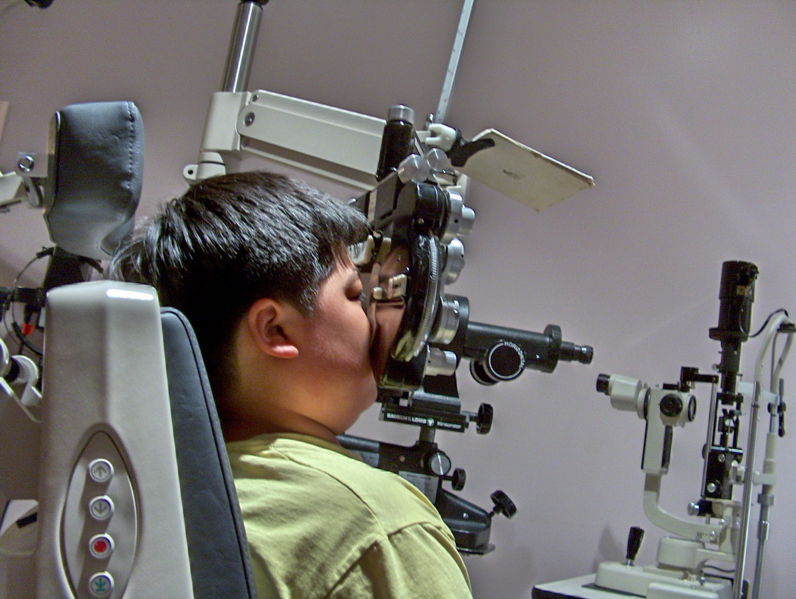
External examination
External examination of eyes consists of inspection of the eyelids, surrounding tissues and palpebral fissure. Palpation of the orbital rim may also be desirable, depending on the presenting signs and symptoms.
The conjunctiva and sclera can be inspected by having the individual look up, and shining a light while retracting the upper or lower eyelid. The cornea and iris may be similarly inspected.
Assessment of Visual Acuity:
The first part of the eye exam is an assessment of acuity. This can be done with either a standard Snellen hanging wall chart read with the patient standing at a distance of 20 feet or a specially designed pocket card (held at 14 inches). Each eye is tested independently (i.e. one is covered while the other is used to read). The patient should be allowed to wear their glasses and the results are referred to as "Best corrected vision." You do not need to assess their ability to read every line on the chart. If they have no complaints, rapidly skip down to the smaller characters. The numbers at the end of the line provide an indication of the patient's acuity compared with normal subjects. The larger the denominator, the worse the acuity. 20/200, for example, means that they can see at 20 feet what a normal individual can at 200 feet (i.e. their vision is pretty lousy). If the patient is unable to read any of the lines, indicative of a big problem if this was a new complaint, a gross estimate of what they are capable of seeing should be determined (e.g. ability to detect light, motion or number of fingers placed in front of them). In general, acuity is only tested when there is a new, specific, visual complaint.
Visual acuity is the eye's ability to detect fine details and is the quantitative measure of the eye's ability to see an in-focus image at a certain distance. The standard definition of normal visual acuity (20/20 or 6/6 vision) is the ability to resolve a spatial pattern separated by a visual angle of one minute of arc. The terms 20/20 and 6/6 are derived from standardized sized objects that can be seen by a "person of normal vision" at the specified distance. For example, if one can see at a distance of 20 ft an object that normally can be seen at 20 ft, then one has 20/20 vision. If one can see at 20 ft what a normal person can see at 40 ft, then one has 20/40 vision. Put another way, suppose you have trouble seeing objects at a distance and you can only see out to 20 ft what a person with normal vision can see out to 200 feet, then you have 20/200 vision. The 6/6 terminology is more commonly used in Europe and Australia, and represents the distance in meters. This is often measured with a Snellen chart.

(Image courtesy of Charlie Goldberg, M.D.)
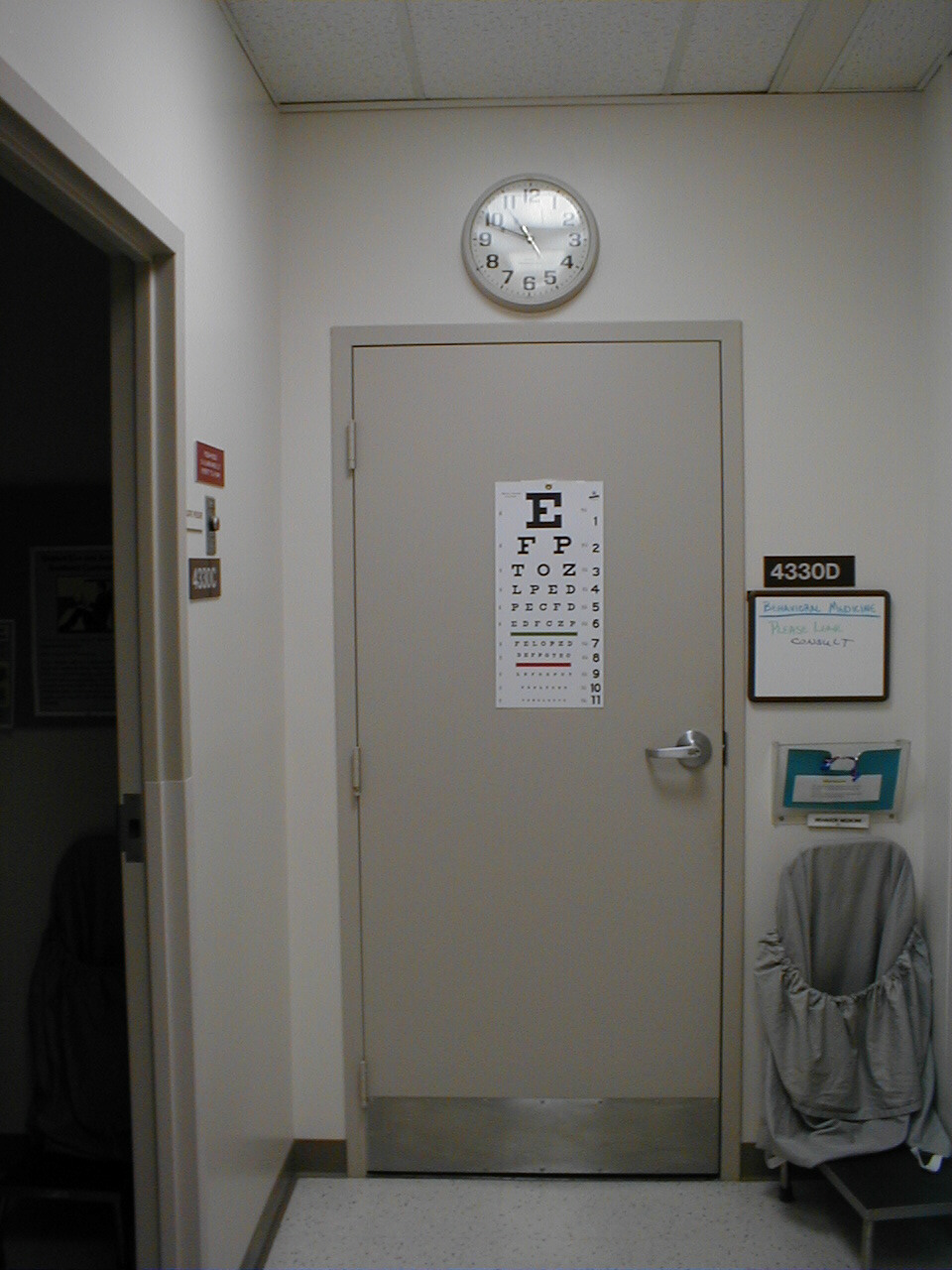
(Image courtesy of Charlie Goldberg, M.D.)
Pinhole Testing:
The pinhole testing device can determine if a problem with acuity is the result of refractive error (and thus correctable with glasses) or due to another process. The pinholes only allow the passage of light which is perpendicular to the lens, and thus does not need to be bent prior to being focused onto the retina. The patient is instructed to view the Snellen chart with the pinholes up (below) and then again with them in the down position (below). If the deficit corrects with the pinholes in place, the acuity issue is related to a refractive problem.
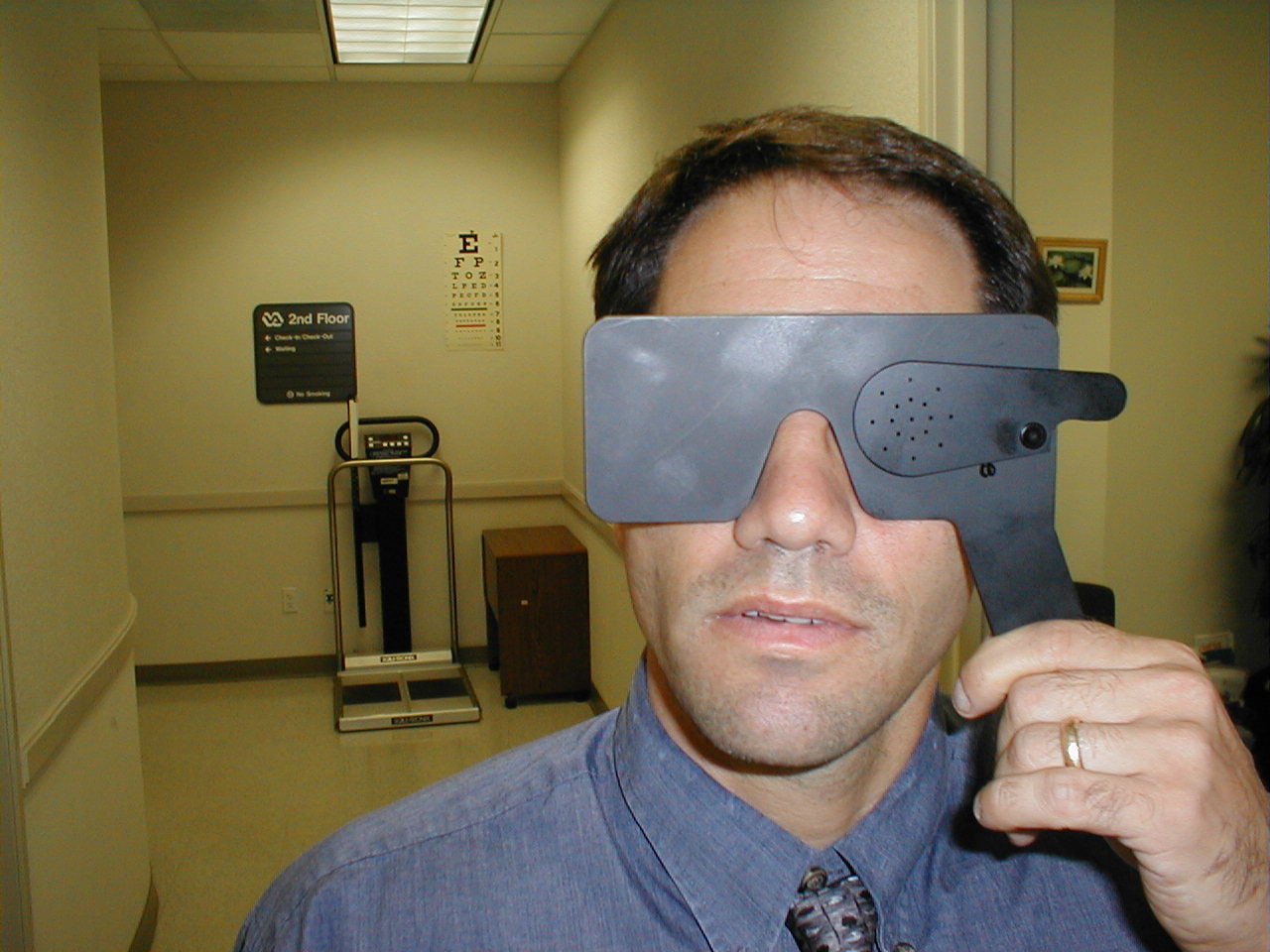
(Image courtesy of Charlie Goldberg, M.D.)
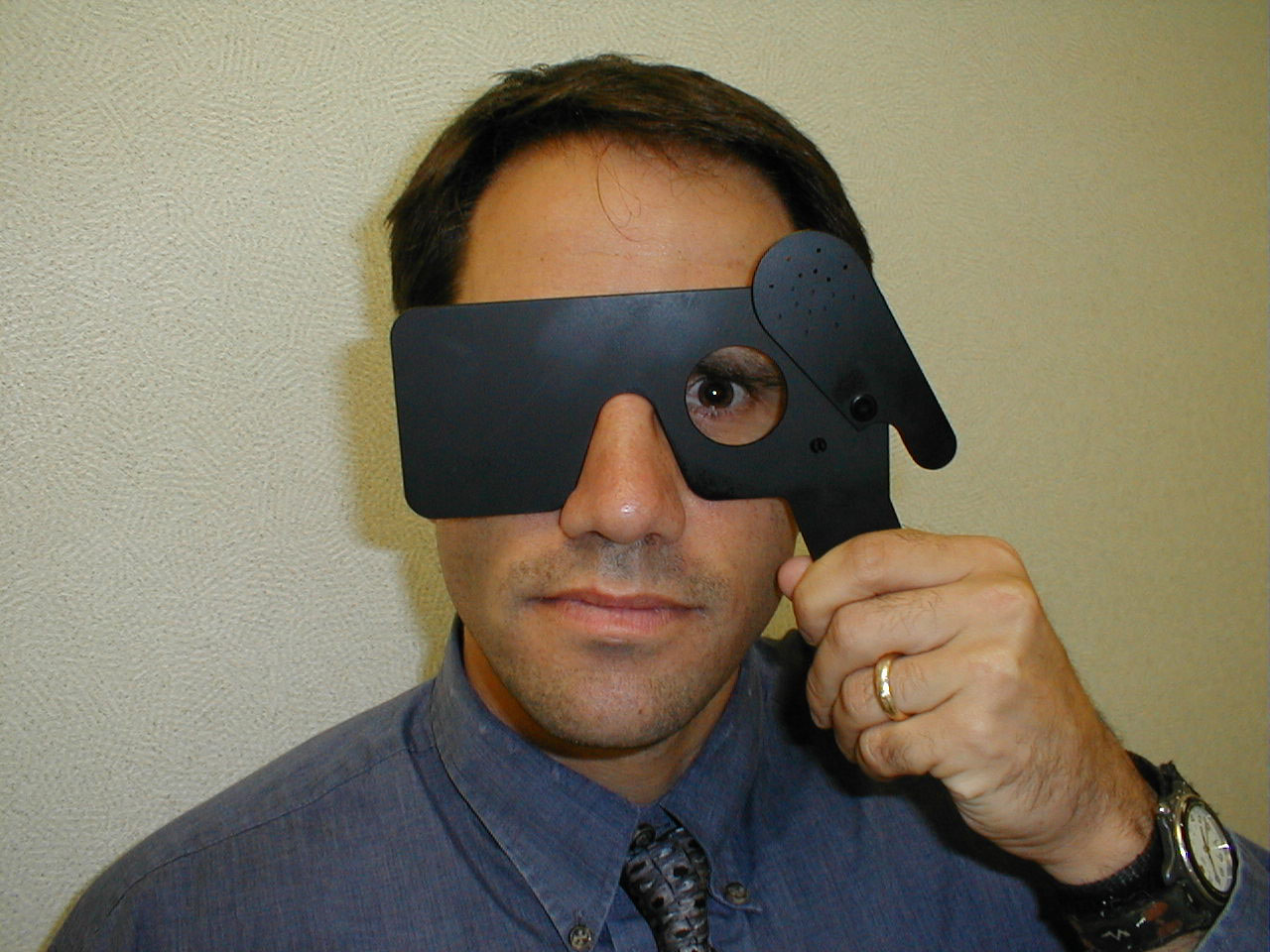
(Image courtesy of Charlie Goldberg, M.D.)
Observation of External Structures:
Ocular Symmetry:
Occasionally, one of the muscles that controls eye movement will be weak or foreshortened, causing one eye to appear deviated medially or laterally compared with the other.
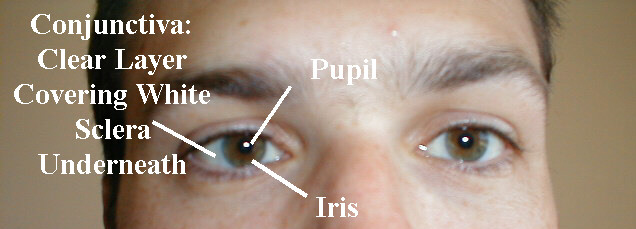
(Image courtesy of Charlie Goldberg, M.D.)
Eye Lid Symmetry:
Both eye lids should cover approximately the same amount of eyeball. Damage to the nerves controlling these structures (Cranial Nerves 3 and 7) can cause the upper or lower lids on one side to appear lower then the other.
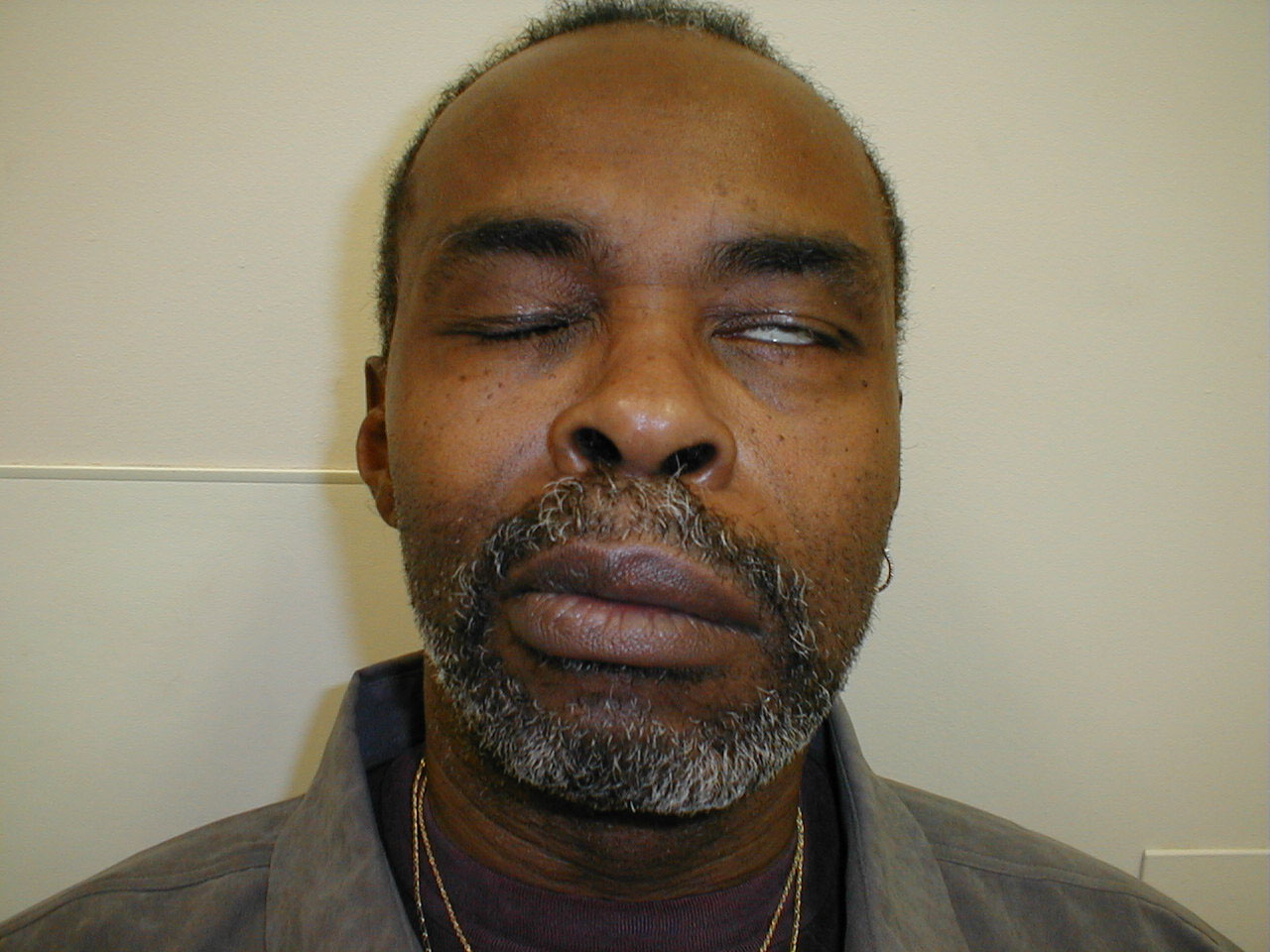
(Image courtesy of Charlie Goldberg, M.D.)
Sclera:
The normal sclera is white and surrounds the iris and pupil. In the setting of liver or blood disorders that cause hyperbilirubinemia, the sclera may appear yellow, referred to as icterus. This can be easily confused with a muddy-brown discoloration common among older African Americans that is a variant of normal.
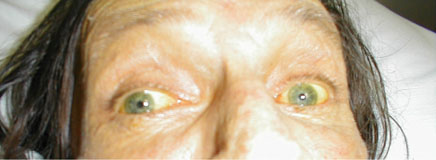
(Image courtesy of Charlie Goldberg, M.D.)
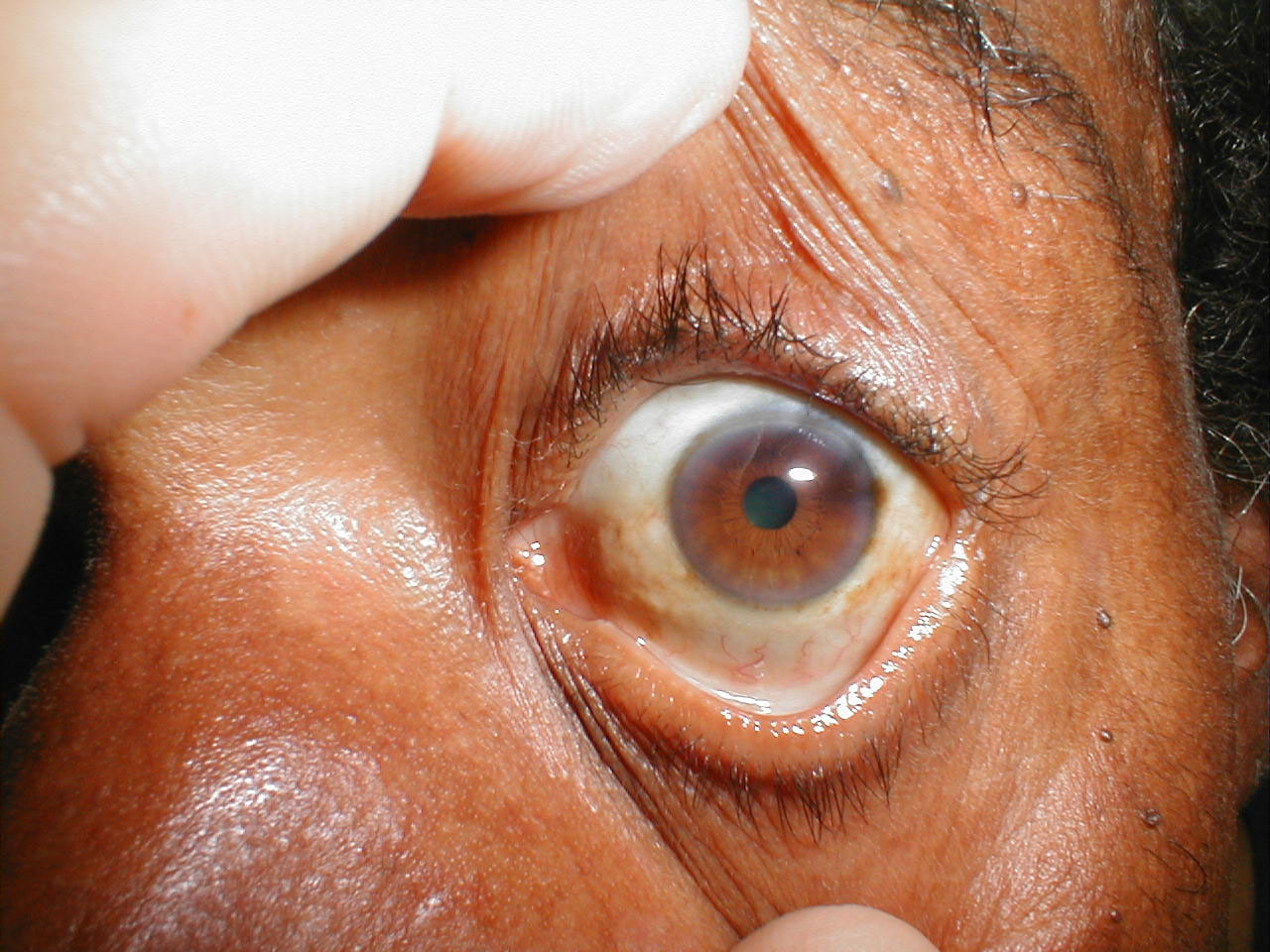
(Image courtesy of Charlie Goldberg, M.D.)
Conjunctiva:
The sclera is covered by a thin transparent membrane known as the conjunctiva, which reflects back onto the underside of the eyelids. Normally, it's invisible except for the fine blood vessels that run through it. When infected or otherwise inflamed, this layer can appear quite red, a condition known as conjunctivitis. Alternatively, the conjunctiva can appear pale if patient is very anemic. By gently applying pressure and pulling down and away on the skin below the lower lid, you can examine the conjunctival reflection, which is the best place to identify this finding.
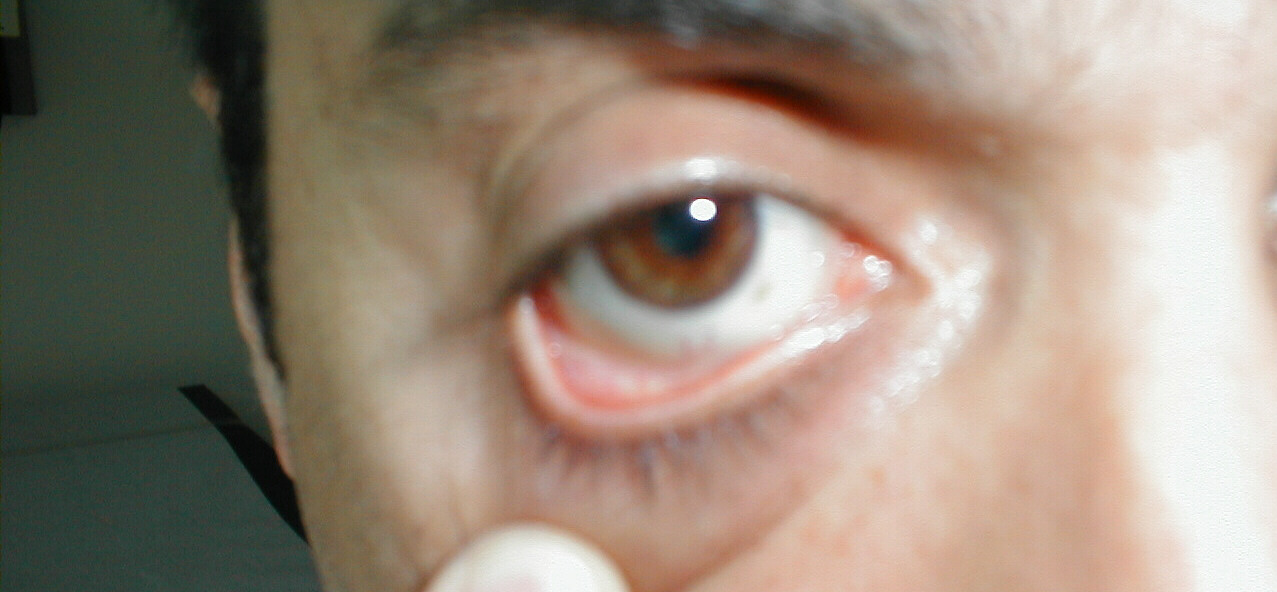
(Image courtesy of Charlie Goldberg, M.D.)
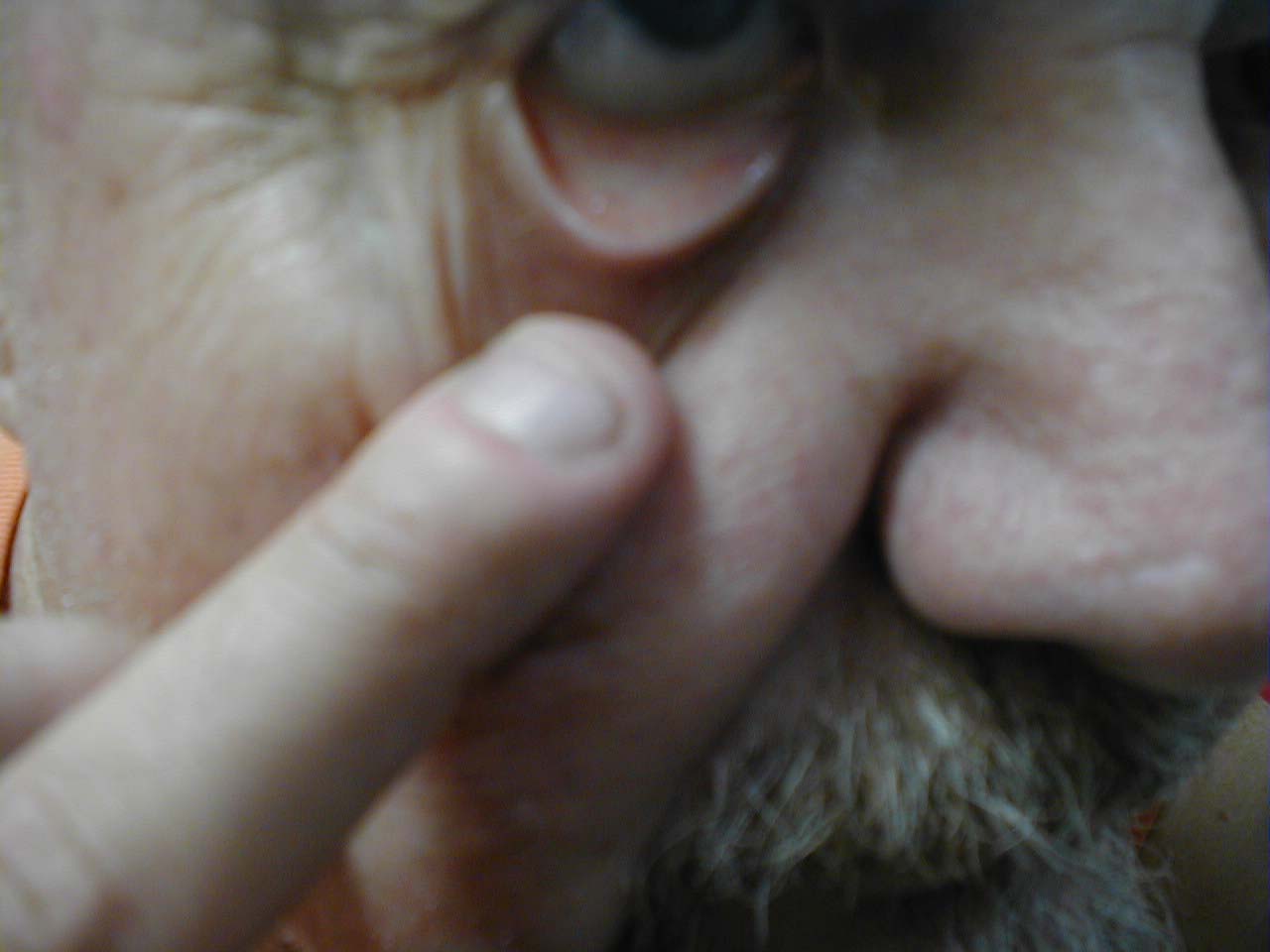
(Image courtesy of Charlie Goldberg, M.D.)
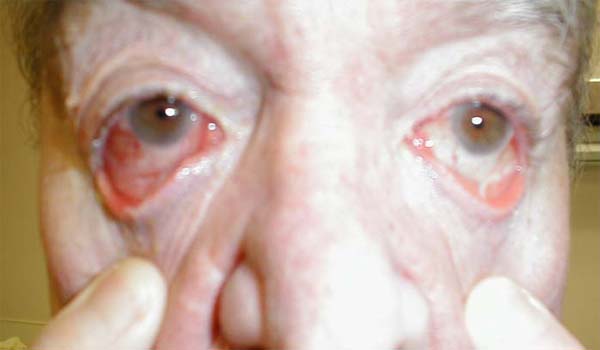
(Image courtesy of Charlie Goldberg, M.D.)
Blood can also accumulate underneath the conjunctiva when one of the small blood vessels within it ruptures. This may be the result of relatively minor trauma (cough, sneeze, or direct blow), a bleeding disorder or idiopathic. The resulting collection of blood is called a subconjunctival hemorrhage. While dramatic, it is generally self limited and does not affect vision.
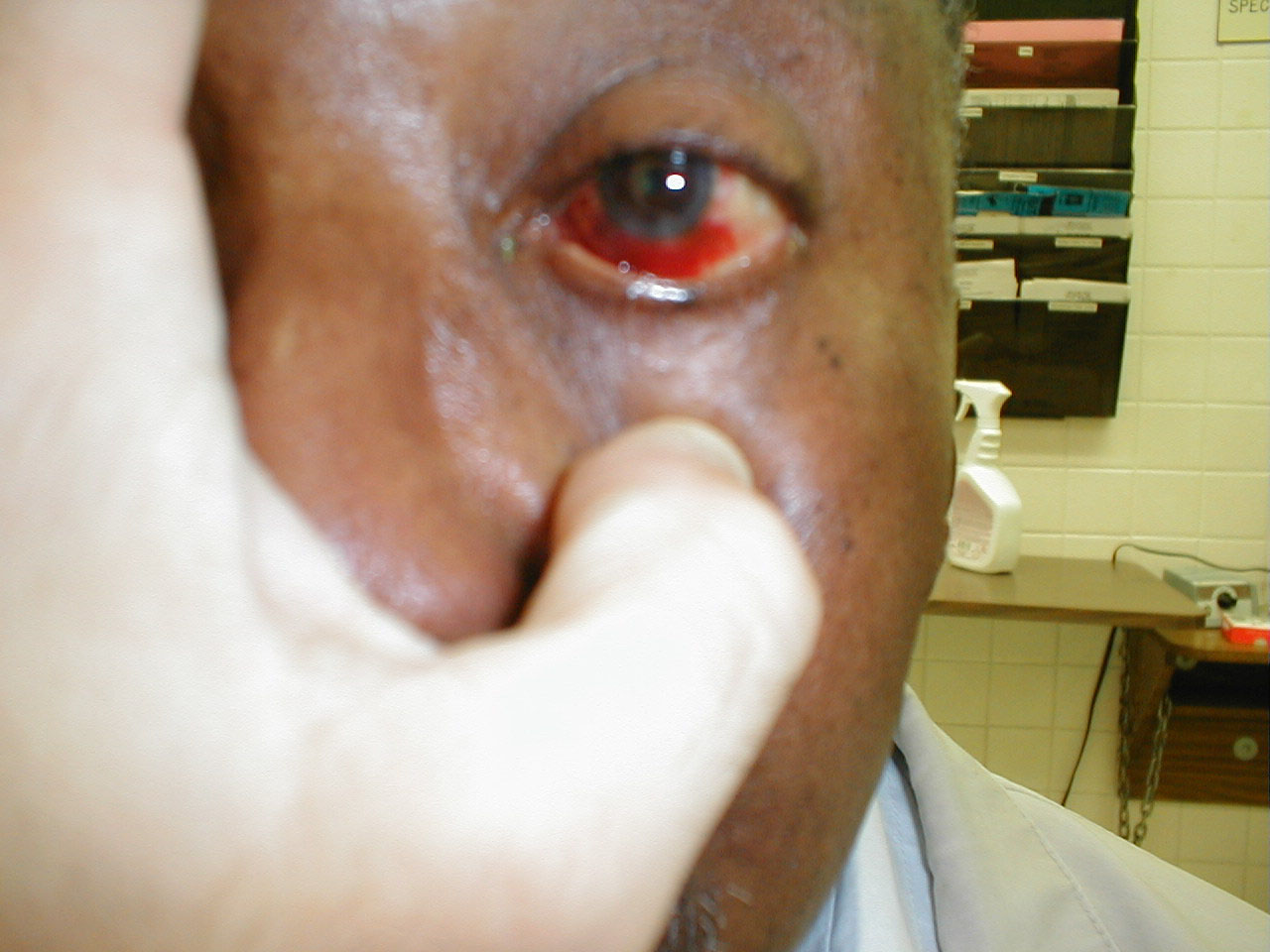
(Image courtesy of Charlie Goldberg, M.D.)
Pupil and Iris:
Normally, both of these structures are round and symmetric.
When performing the rest of the exam, make sure that you are in a comfortable position. The critical maneuver is assuring that the patient is seated at a height such that their eyes are essentially on the same level as your own when you are standing next to them.
An examination of pupilary function includes inspecting the pupils for equal size (1 mm or less of difference may be normal), regular shape, reactivity to light, and direct and consensual accommodation.
These steps can be easily remembered with the mnemonic PERRLA (D+C): Pupils Equal and Regular; Reactive to Light and Accommodation (Direct and Consensual).
A swinging-flashlight test may also be desirable if neurologic damage is suspected.
The swinging-flashlight test is the most useful clinical test available to a general physician for the assessment of optic nerve anomalies.
This test detects the afferent pupil defect, also referred to as the Marcus Gunn pupil.
In a normal reaction to the swinging-flashlight test, both pupils constrict when one is exposed to light.
As the light is being moved from one eye to another, both eyes begin to dilate, but constrict again when light has reached the other eye.
If there is an efferent defect in the left eye, the left pupil will remain dilated regardless of where the light is shining, while the right pupil will respond normally.
If there is an afferent defect in the left eye, both pupils will dilate when the light is shining on the left eye, but both will constrict when it is shining on the right eye.
If there is a unilateral small pupil with normal reactivity to light, it is unlikely that a neuropathy is present.
However, if accompanied by ptosis of the upper eyelid, this may indicate Horner's syndrome.
If there is a small, irregular pupil that constricts poorly to light, but normally to accommodation, this is an Argyll Robertson pupil.
Testing Extra-Ocular Movements:
Ocular motility should always be tested, especially when patients complain of double vision or physicians suspect neurologic disease.
First, the doctor should visually assess the eyes for deviations that could result from strabismus, extraocular muscle dysfunction, or palsy of the cranial nerves innervating the extraocular muscles.
Saccades are assessed by having the patient move his or her eye quickly to a target at the far right, left, top and bottom. This tests for saccadic dysfunction whereupon poor ability of the eyes to "jump" from one place to another may impinge on reading ability and other skills.
Slow tracking, or "pursuits" are assessed by the 'follow my finger' test, in which the examiner's finger traces an imaginary "double-H", which touches upon the eight fields of gaze.
These test the inferior, superior, lateral and medial rectus muscles of the eye, as well as the superior and inferior oblique muscles.
Instruct the patient to follow your index finger with their eyes only (i.e. their head remains in one position) as you first move it to either the extreme right or left. Then, once you have the patient looking out laterally, have them follow your finger as you move it first up, then down. Now move your finger across to the other side and repeat. Your path should trace out the letter H. At the end, bring your finger directly in towards the patient's nose. This will cause the patient to look cross-eyed and the pupils should constrict, a response referred to as accommodation.
Tracing out this path allows you to test each of the extra-ocular muscles individually and avoids movements that are dependent on more then one muscle, as occurs if you have the patient look up or down while the pupil is oriented straight ahead. Assessments of both extra-ocular movements and visual acuity are actually tests of cranial nerve (CN) function. CNs 3, 4, and 6 control movement and CN 2 vision. As these nerves are critical to eye function, it makes sense to evaluate them at this stage rather then during the neurological examination.
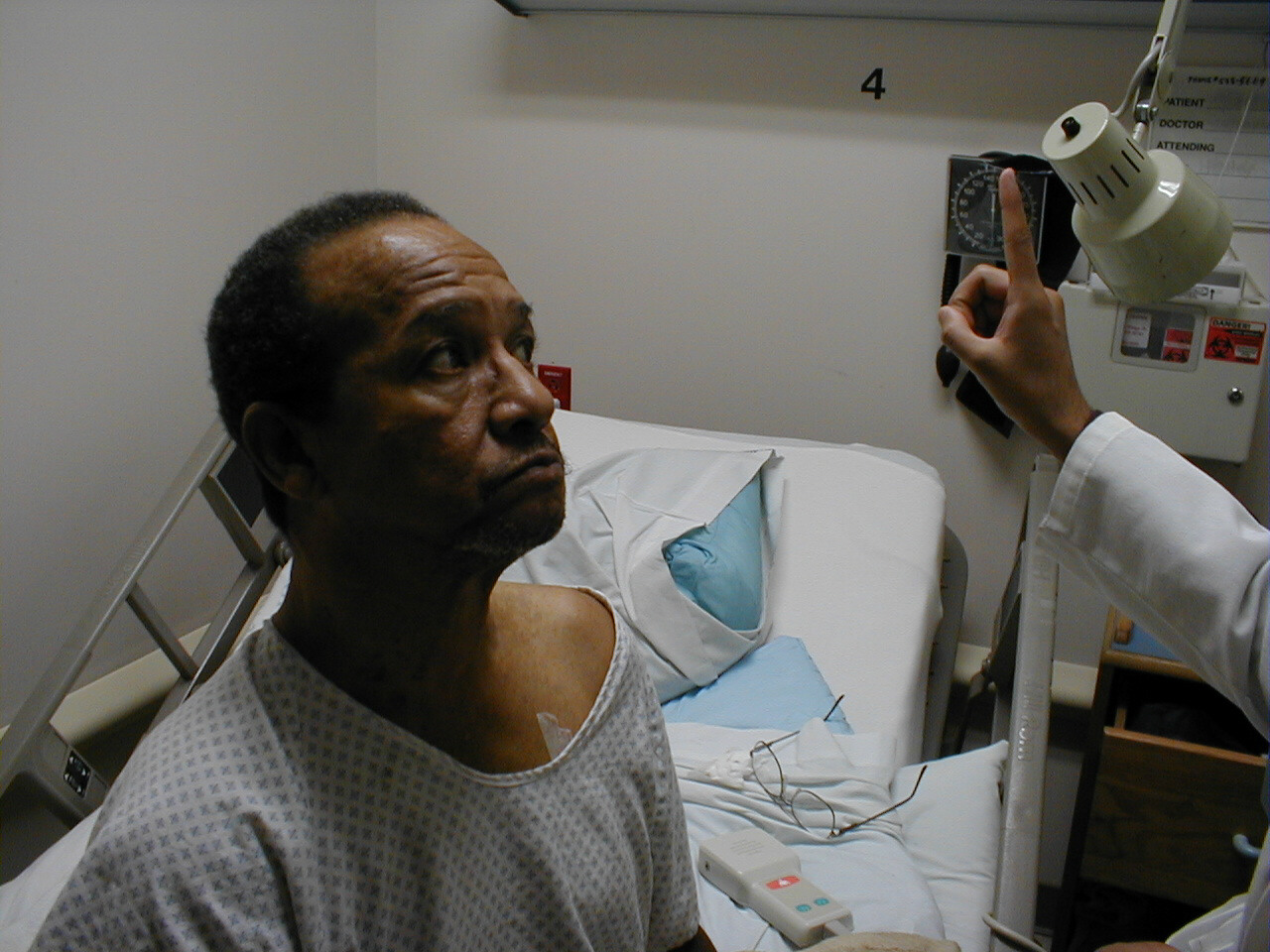
(Image courtesy of Charlie Goldberg, M.D.)

(Image courtesy of Charlie Goldberg, M.D.)
The cranial nerves and the muscles that they innervate can be remembered using the following mnemonic: SO '4', LR '6', all the rest '3.' Each CN permits the following movements:
- CN 4: Innervates the superior oblique muscle. Allows you to move either eyeball down and inward.
- CN 6: Innervates the lateral rectus muscle. Allows you to move either eyeball laterally.
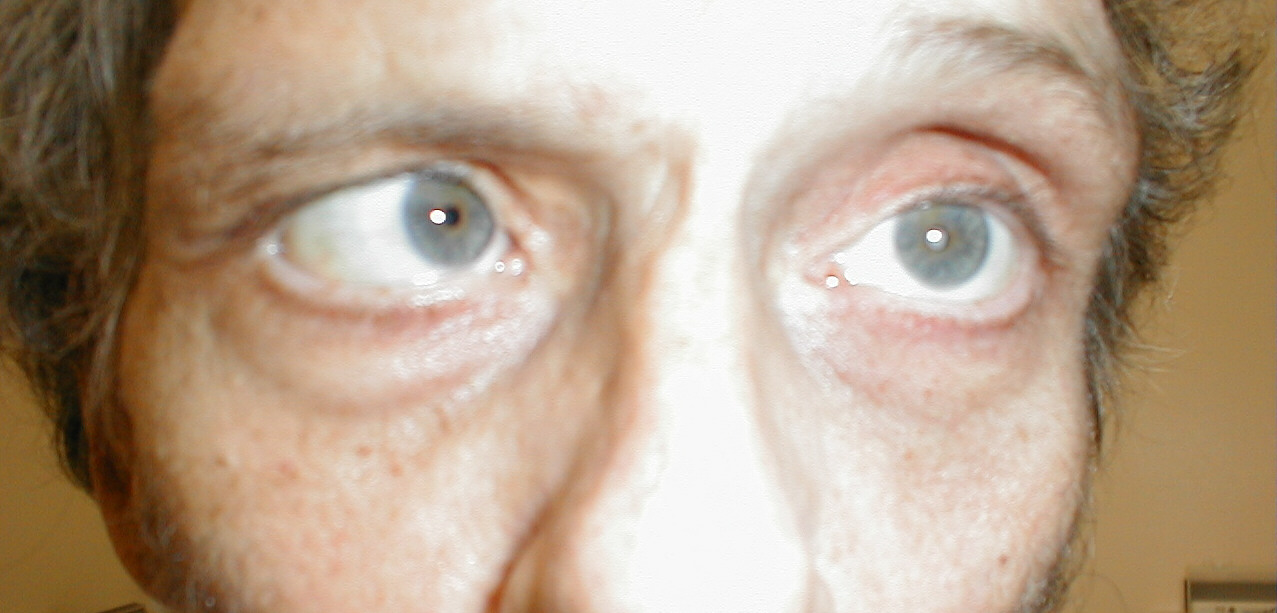
(Image courtesy of Charlie Goldberg, M.D.)
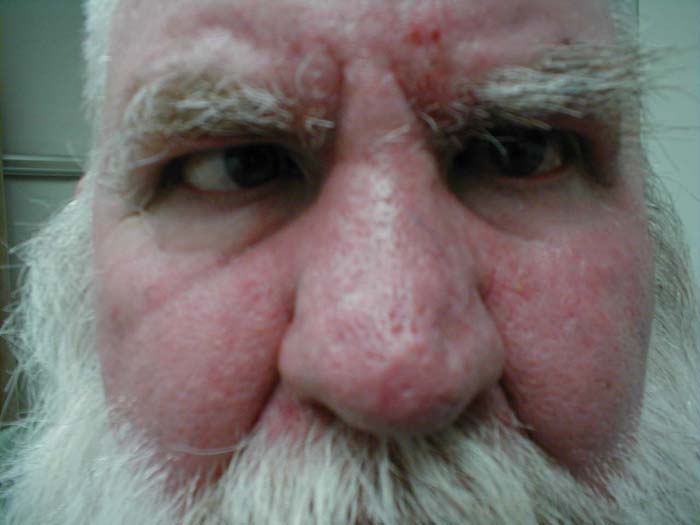
(Image courtesy of Charlie Goldberg, M.D.)
- CN 3: Innervates the remaining extra ocular muscles as well as the upper eye lid. Therefore allows eyeball movement in all remaining directions as well as lifting of the upper lid. The dilation is due to disruption of the parasympathetic fibers which run along the outside of CN3.

(Image courtesy of Charlie Goldberg, M.D.)
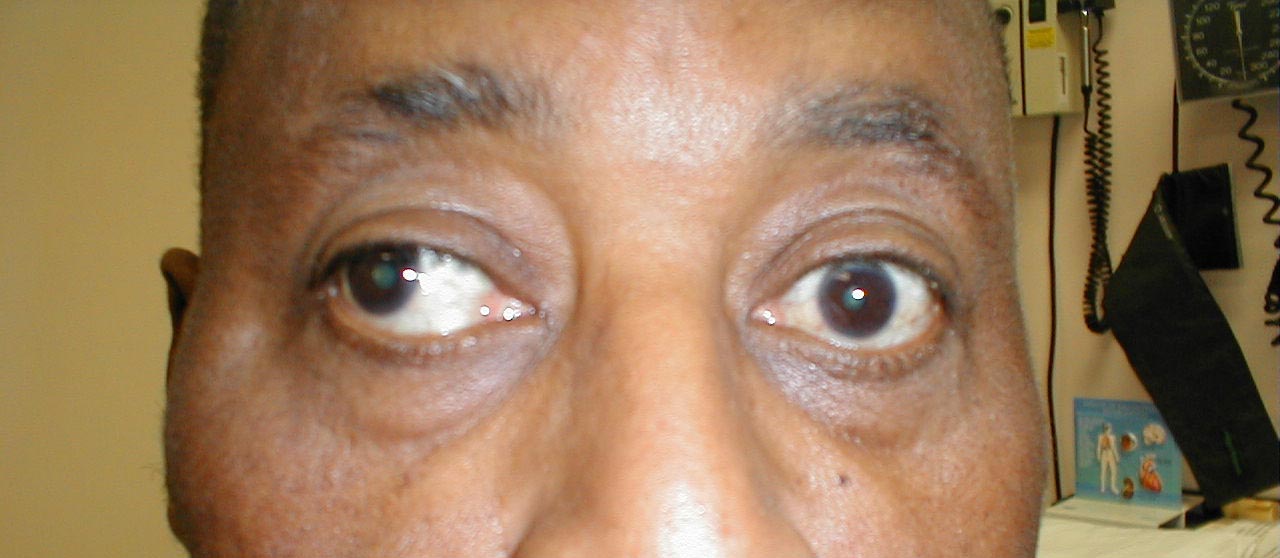
(Image courtesy of Charlie Goldberg, M.D.)
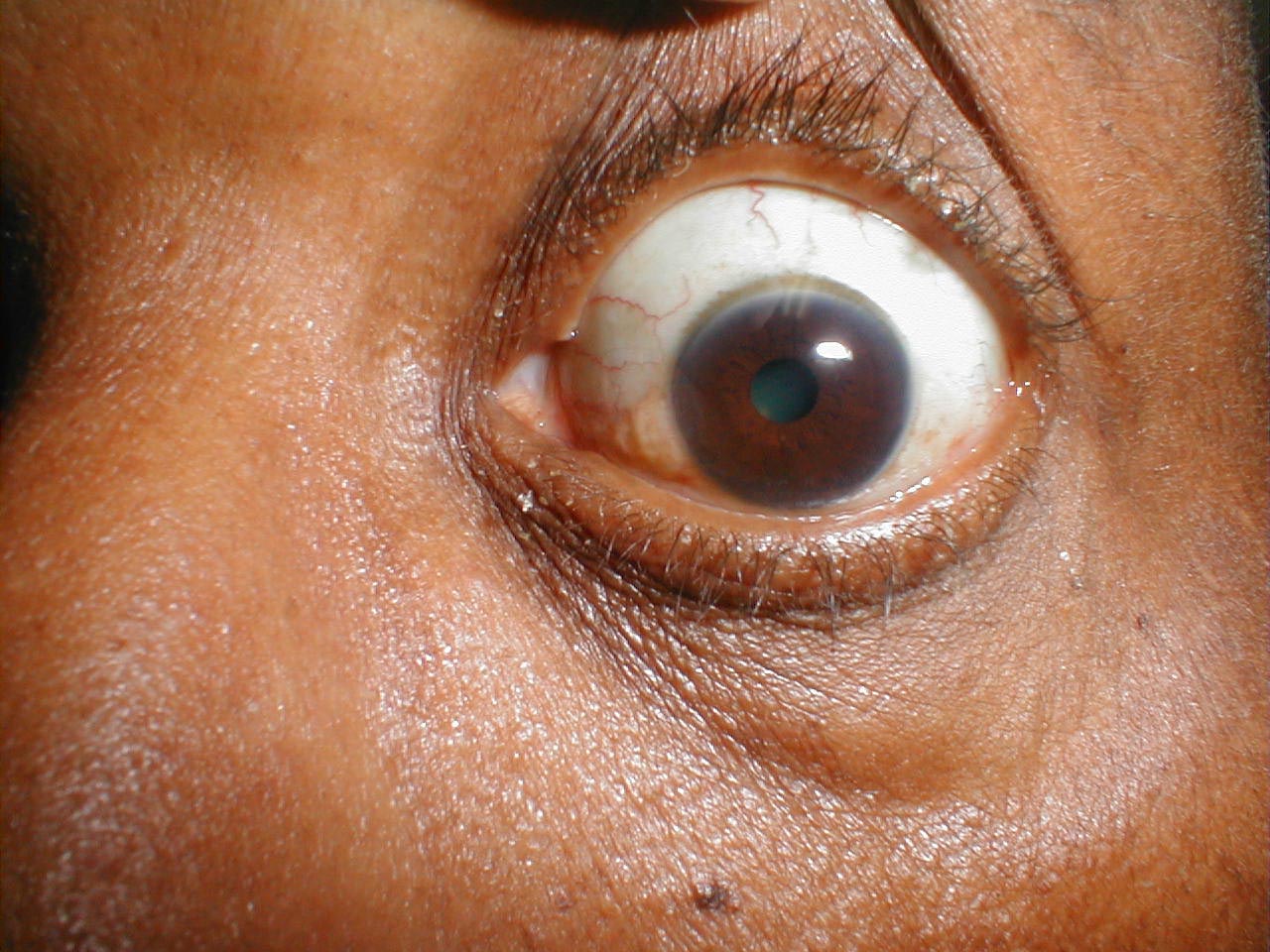
(Image courtesy of Charlie Goldberg, M.D.)
Disorders of eye movement can also be due to problems with the extraocular muscles themselves. For example, pictured below is a patient who has suffered a traumatic left orbital injury. The inferior rectus muscle has become entrapped within the resulting fracture, preventing the left eye from being able to look downward.
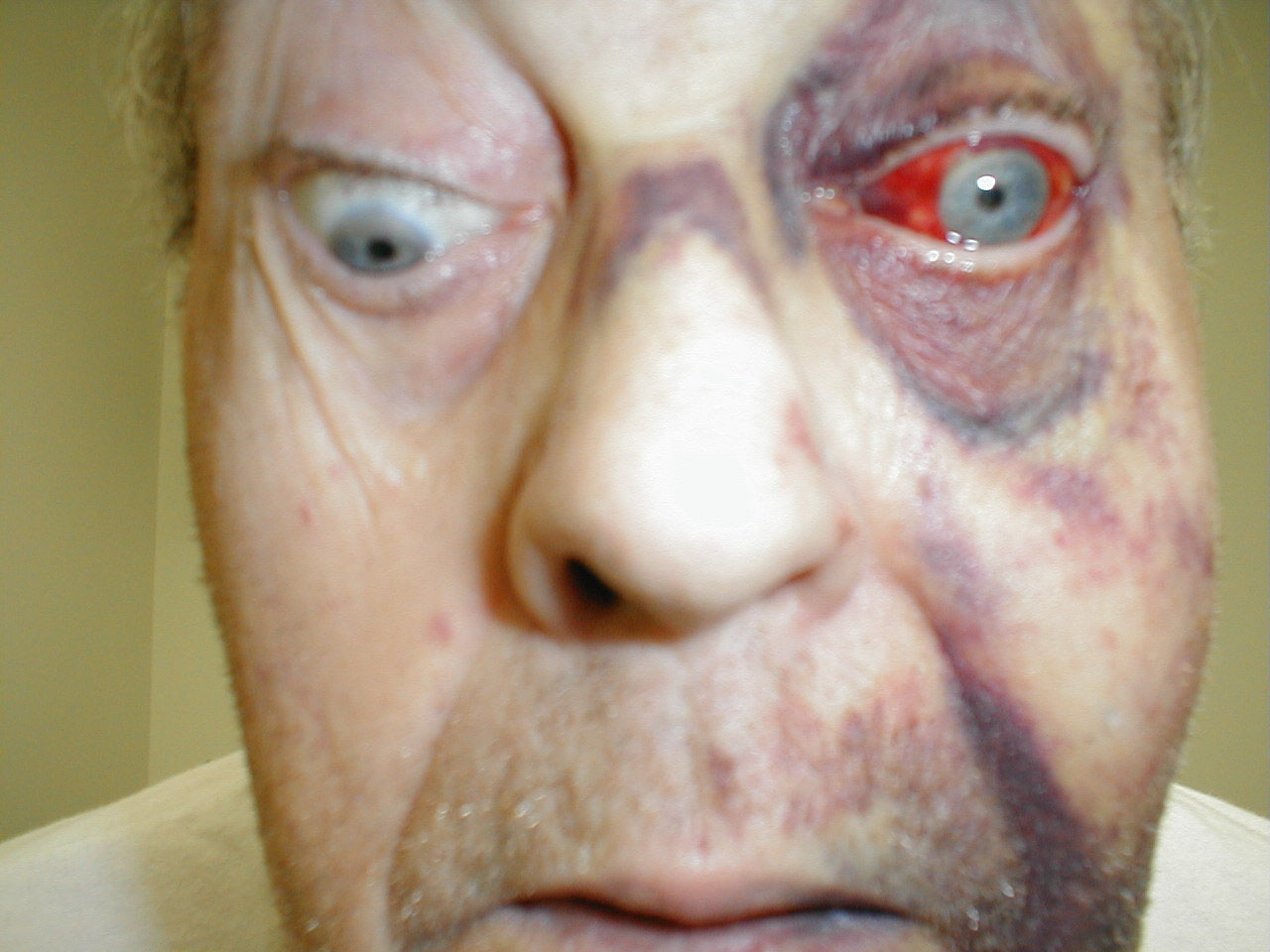
(Image courtesy of Charlie Goldberg, M.D.)
Visual field (confrontation) testing
Evaluation of the visual fields should never be omitted from the basic eye examination.
Testing the visual fields consists of confrontation field testing in which each eye is tested separately to assess the extent of the peripheral field. To perform the test, the individual occludes one eye while fixated on the examiner's eye with the non-occluded eye.
The patient is then asked to count the number of fingers that are briefly flashed in each of the four quadrants.
This method is preferred to the wiggly finger test that was historically used because it represents a rapid and efficient way of answering the same question: is the peripheral visual field affected?
Common problems of the visual field include scotoma (area of reduced vision), hemianopia (half of visual field lost), homonymous quadrantanopia (involving both eyes) and bitemporal hemianopia.
The normal visual field for each eye extends out from the patient in all directions, with an area of overlap directly in front. Field cuts refer to specific regions where the patient has lost their ability to see. This occurs when the transmitted visual impulse is interrupted at some point in its path from the retina to the visual cortex in the back of the brain. You would, in general, only include a visual field assessment if the patient complained of loss of sight; in particular "blind spots" or "holes" in their vision. Visual fields can be crudely assessed as follows:
- The examiner should be nose to nose with the patient, separated by approximately 8 to 12 inches.
- Each eye is checked separately. The examiner closes one eye and the patient closes the one opposite. The open eyes should then be staring directly at one another.
- The examiner should move their hand out towards the periphery of his/her visual field on the side where the eyes are open. The finger should be equidistant from both persons.
- The examiner should then move the wiggling finger in towards them, along an imaginary line drawn between the two persons.The patient and examiner should detect the finger at more or less the same time.
- The finger is then moved out to the diagonal corners of the field and moved inwards from each of these directions. Testing is then done starting at a point in front of the closed eyes. The wiggling finger is moved towards the open eyes.
- The other eye is then tested.
Meaningful interpretation is predicated upon the examiner having normal fields, as they are using themselves for comparison.
If the examiner cannot seem to move their finger to a point that is outside the patient's field don't worry, as it simply means that their fields are normal.
Interpretation: This test is rather crude, and it is quite possible to have small visual field defects that would not be apparent on this type of testing. Prior to interpreting abnormal findings, the examiner must understand the normal pathways by which visual impulses travel from the eye to the brain.
Intraocular pressure
Intraocular pressure is mainly determined by the coupling of the production of aqueous humor from the eye's ciliary body and its drainage through the trabecular meshwork and Schlemm's canal located in the anterior chamber angle.
Intraocular pressure is measured with a tonometer.
Using the Opthalmoscope
Ophthalmoscopic examination may include visually magnified inspection of the internal eye structures and also assessment of the quality of the eye's red reflex.
Ophthalmoscopy allows the one to look directly at the retina and other tissue at the back of the eye. This is best done after the pupil has been dilated with eye drops. A limited view can be obtained through an undilated pupil, in which case best results are obtained with the room darkened and the patient looking towards the far corner.
The appearance of the optic disc and retinal vasculature are the main focus of examination during ophthalmoscopy. Anomalies in the appearance of these internal ocular structures may indicate eye disease or condition.
A red reflex can be seen when looking at a patient's pupil through a direct ophthalmoscope. This part of the examination is done from a distance of about 50 cm and is usually symmetrical between the two eyes. An opacity may indicate a cataract.
This aspect of the exam is, at least initially, quite awkward. Don't worry, it will get easier with practice! Take some time to play with your scope, paying attention to its assembly, on/off mechanism as well as the various lens and light settings which can be utilized. There are a number of different brands on the market and each is a bit different. For the purposes of the general exam, we'll focus on the simplest settings and most basic techniques.

(Image courtesy of Charlie Goldberg, M.D.)
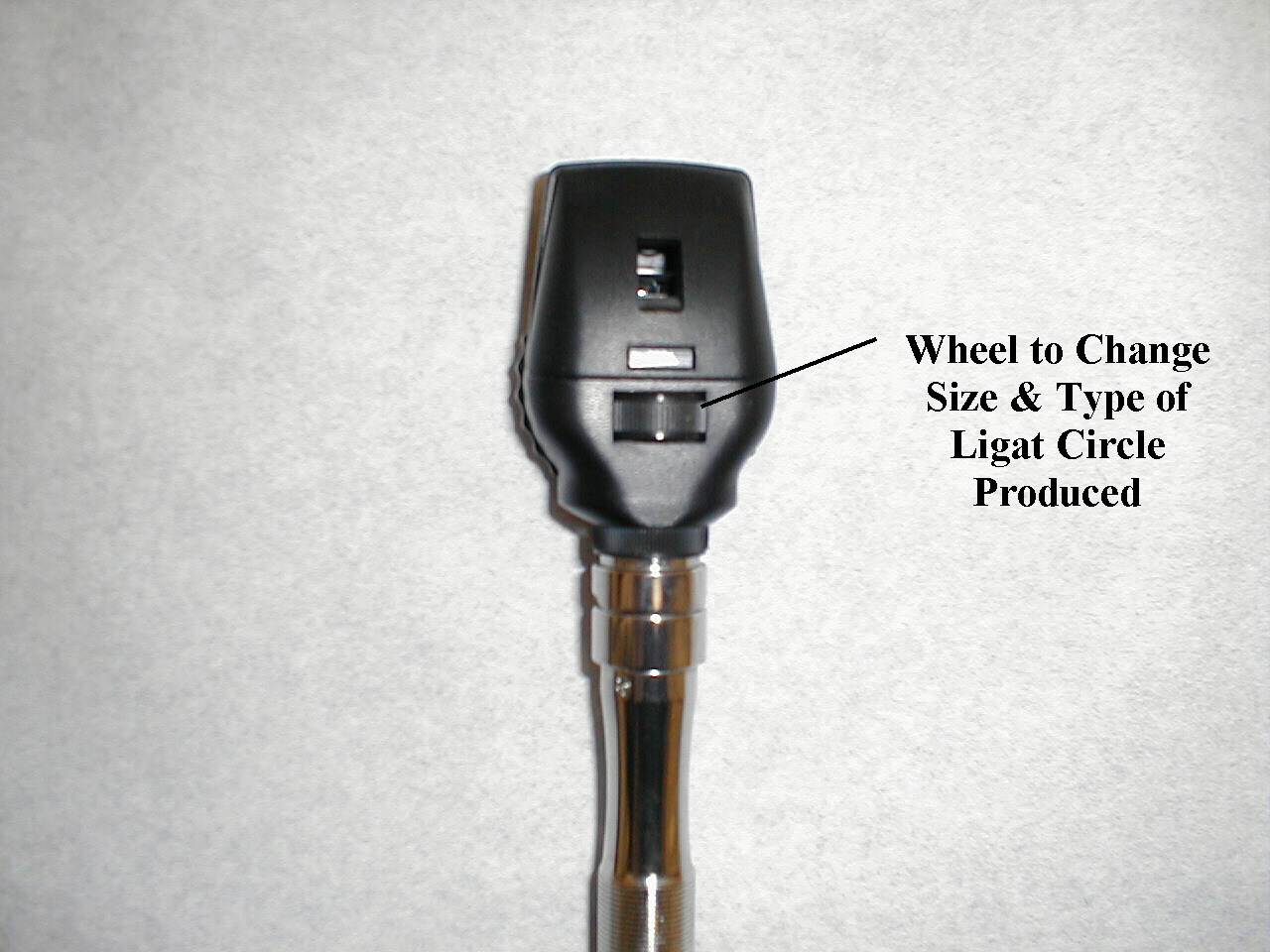
(Image courtesy of Charlie Goldberg, M.D.)
Assessing Pupillary Response to Light:
The normal pupil constricts when either exposed directly to bright light or when that same light is presented to the other eye, referred to as the consensual response. This is due to the fact that stimulation of the afferent (i.e. sensory, carried with CN 2) nerves in one eye will trigger efferent (i.e. motor, carried with CN 3) activation and subsequent constriction of the pupils of both eyes. Disease affecting either the efferent or afferent limbs will alter these responses accordingly. Also, processes which raise intracranial pressure (e.g. brain tumors, collections of blood) can cause CN 3 dysfunction, resulting in dilatation of the pupils and unresponsiveness to direct stimulation by light. To assess pupillary reactions, proceed as follows:
- Instruct the patient to look towards a distant area in the room (e.g. the corner where the wall and ceiling meet) while keeping both of their eyes open. You may need to gently remind them throughout the exam to continue looking in that direction as it is very difficult to examine a roving eyeball. Do not ask them to focus on a specific object as this will lead to pupillary constriction.
- Turn on your opthalmoscope and adjust the light intensity to mid-range power. The cone of light produced should be a white, medium sized circle. Circle sizes available include small, medium and large. If possible, turn off most of the lights in the room. This allows the pupil to dilate and cuts down on reflections from the surface of the eye.
- Make note of the size and shape of each pupil. Then assess whether each pupil constricts appropriately in response to direct and indirect stimulation. If you're having trouble detecting any change, have the patient close their eye for several seconds and place your hand over their eyebrows to provide additional shade. This helps to make it as dark as possible, encouraging greater pupillary dilation and therefore accentuating any change which may occur after light is introduced. It may be hard to detect the consensual response if the lighting in your room is sub-optimal (i.e. if it's too dark, you won't be able to see the other eye). Note that you do not need to look through the viewing window of the scope to perform this part of the exam as you are essentially using it as a flashlight.
Slit-lamp
Close inspection of the anterior eye structures and ocular adnexa are often done with a slit lamp machine. A small beam of light that can be varied in width, height, incident angle, orientation and colour, is passed over the eye. Often, this light beam is narrowed into a vertical "slit", during slit-lamp examination. The examiner views the illuminated ocular structures, through an optical system that magnifies the image of the eye.
This allows inspection of all the ocular media, from cornea to vitreous, plus magnified view of eyelids, and other external ocular related structures. Fluorescein staining before slit lamp examination may reveal corneal abrasions or herpes simplex infection.
The binocular slit-lamp examination provides stereoscopic magnified view of the eye structures in striking detail, enabling exact anatomical diagnoses to be made for a variety of eye conditions.
Also ophthalmoscopy and gonioscopy examinations can also be performed through the slit lamp when combined with special lenses. These lenses include the Goldmann 3-mirror lens, gonioscopy single-mirror/ Zeiss 4-mirror lens for (ocular) anterior chamber angle structures and +90D lens, +78D lens, +66D lens & Hruby (-56D) lens, the examination of retinal structures is accomplished.
Closer Exam of the Outer Structures of the Eye:
- Every opthalmoscope has a mechanism for changing the viewing lens. These lenses vary in their ability to bend light and are numbered and color coded. The specific lens that allows you to see something in focus will vary with your distance from that structure as well as the refractive error of both your eyes and the patients. To better examine the sclera, conjunctiva, pupil, cornea or iris, start with the lens identified by a green 4 or 6.
- Now grasp the handle with your right hand (the following instructions are for examining the patient's right eye) such that your middle finger is resting on the lower, front aspect of the head of the opthalmoscope.
- Bring your right eye up to the viewing window. While you can either wear or remove your own glasses, the patient's should be taken off. It's OK to leave contacts in place.
- Take your left hand and place it on the patient's forehead and gently apply upward traction on the top lid with your thumb. This will "remind" them not to blink and let you know their precise location. Obviously, try not to poke them in the eye with this finger! Alternatively, you can place your left hand on the patient's shoulder as a means of keeping track of their location. Try to keep both of your eyes open when performing the exam as you might find it quite tiring to continually squint with the non-examining eye.
- Start approximately 15 cm from the patient and approach from about 15 or 20 degrees to the left of center. When you look through the viewing window, the outer structures of the eye should come into sharp focus. If not, slowly move closer or further from the patient until these structures become clear. It takes a bit of experimentation to find the lens that is right for any given distance, so make lens changes slowly by rotating the adjustment wheel. There is no magic way of guessing which lens will allow the sharpest view.
- Most clinicians don't perform a detailed examination of the outer structures of the eye if the patient has neither obvious abnormalities nor complaints referable to this region
Viewing the Fundus (the retina and associated structures):
- Repeat steps 1 thru 5 as above. Adjust the lens selection wheel so that 0 appears in the display window.

(Image courtesy of Charlie Goldberg, M.D.)
- Look through the viewing window at the patient's pupil, using your right eye to examine their right eye. You should see a sparkly, orange-red color known as the red reflex. This is caused by light reflecting off of the retina and is the same phenomenon that produces red eyes in flash photographs. Occasionally, the translucent structures which allow light to pass unimpeded from outside the eye to the retina become opacified and the red reflex is lost. In adults, this is most commonly associated with cataracts, a process caused by clouding of the lens.
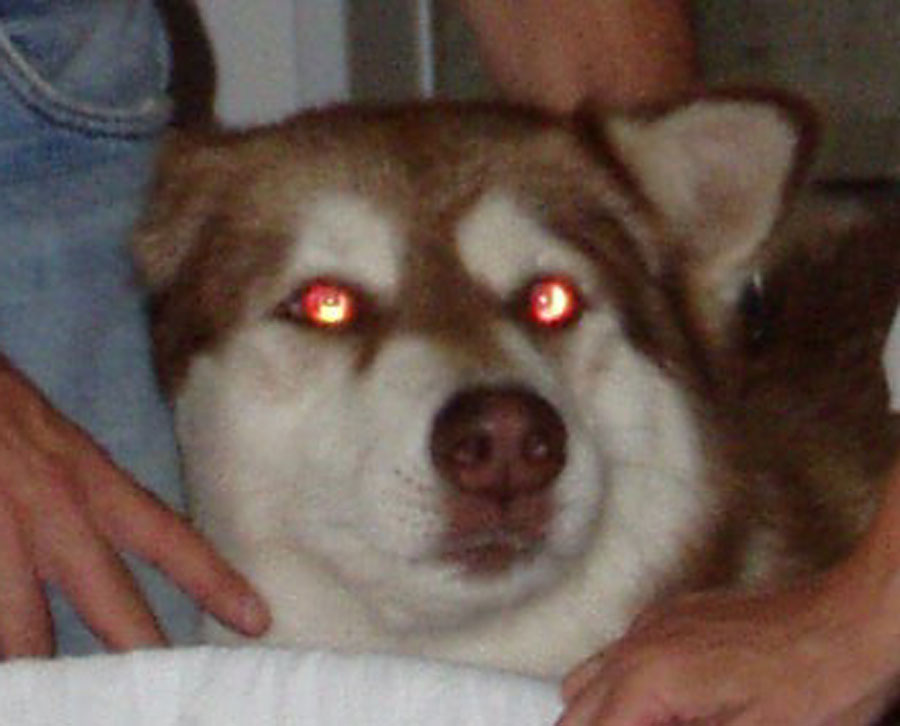
(Image courtesy of Charlie Goldberg, M.D.)
- In order to see the fundus in greater detail, you will need to move very close to the patient, analogous to looking through a key hole (i.e. the closer you are, the more you'll see). Your middle finger, the one resting on the low front of the head piece, should be on or near the patient's cheek. Starting with the 0 lens in place, rotate the adjustment wheel counter clockwise. If you change lenses too quickly, you'll probably whizz right by the one that gives the sharpest picture, so be patient. In the event that this does not bring anything into focus, trying rotating the adjustment wheel in the opposite direction. It doesn't really matter what number lens is required to achieve the clearest view. Again, this will vary with the refractive error of both you and the patient. The numbers are simply provided for reference. Thus, while you may be able to see the fundus of some patients with the green numbers still visible, you will need red 8 or 10 to visualize the same region in a different person. Once you're close in and have the retina in clear view, you should only need to change the lens one or two clicks in order to keep all structures in focus as you scan across.

(Picture Courtesy of Ray Kelly and Charlie Goldberg)
- You will only be able to see a relatively small segment of the retina at any one time. Your initial view will probably be of blood vessels on a random patch of retina (see below).
The retina has a refractile, orange-red appearance, varying a bit with the skin color and age of the patient. Fundoscopy provides important information as it not only enables you to detect diseases of the eyes but is also the only area of the body where small blood vessels can be studied with relative ease. There are a number of chronic systemic diseases (most commonly hypertension, diabetes and atherosclerosis) that affect vessels of this size in a relatively slow and silent fashion. It is, however, frequently impossible to directly assess the extent of this damage during physical examination as the affected organs, e.g. kidneys, are well hidden. Evaluation of the retina provides an opportunity to directly visualize these processes. Based on this information, clinicians can make educated guesses as to what is occurring elsewhere in the body. Having said this, do not be discouraged if it takes a while before you're able to identify structures with any degree of confidence. Practice on every patient that you examine. It will come with time. A few things to pay attention to:
- When you first visualize the retina, you will note branching blood vessels. The bigger, darker ones are the veins and the smaller, brighter red structures the arteries. Changes in the appearance of the arteries (copper wiring) as well as alterations in the arterial-venous crossing pattern (a-v nicking) occur with atherosclerosis and hypertension respectively (see any text for pictures). These vessels are more obvious in the superior and inferior aspects of the retina, with relative sparing of the temporal and medial regions.
- Imagine that the blood vessels are the branches of a tree. Follow them in a direction that leads to less branching (i.e. towards the trunk). This will direct you towards the optic disc, the point at which the vessels enter the retina along with the head of the optic nerve. The edges of this round disc are sharp and well defined in the normal state. It should be a bit more yellow/orange when compared to the rest of the retina. At the center of the disc is the optic cup, a distinct circular area from which the blood vessels actually emerge. The disc is not located in the exact center of the retina but rather towards its medial/nasal aspect. Measurements in the eye are made using disc size as a measuring device (e.g. a finding may be described as being at 2 O'clock, 2 disc diameters from the center of the disc). If you are unable to locate the disc after following the vessels in one direction, simply head the other way.
- The macula is a region located lateral to the optic disc. It looks somewhat darker then the rest of the retina and, as opposed to the disc, has no distinct borders. The macula provides the sharpest vision. It can be best visualized by asking the patient to stare directly at the light of the opthalmoscope while you remain focused on a fixed area of the retina.
- You will not be able to visualize the entire retina at any one time (approximately one disc diameter should be visible). To view different areas, you'll have to shift the angle with which you peer through the pupil. This requires very small movements. Try to examine the entire structure systematically, looking up, down, left and right. You will undoubtedly have to remind the patient to continue looking straight ahead, else the fundus will be in continual motion and you will have no chance of finding anything. It's also a good idea to periodically give the patient a break (particularly if the exam is taking a while), allowing them to blink in the dark before resuming.
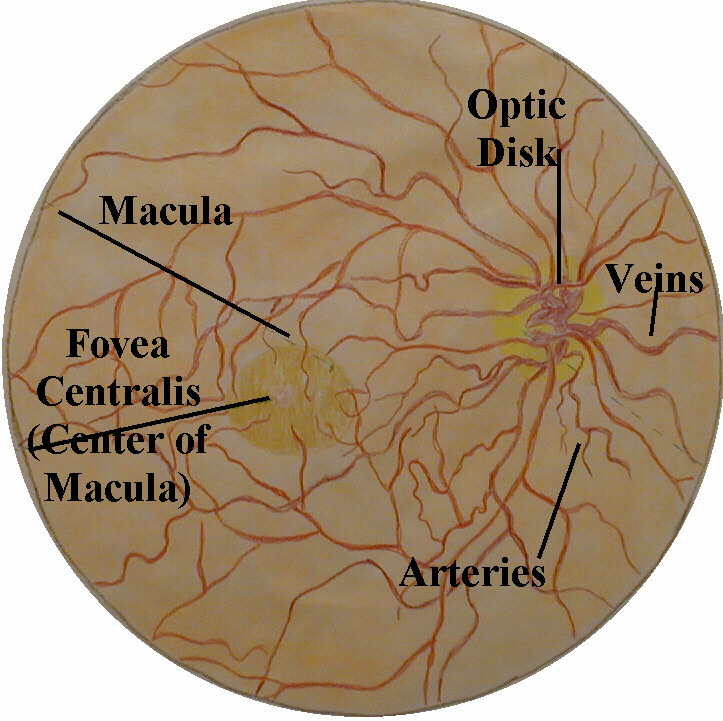
(Picture Courtesy of Ray Kelly and Charlie Goldberg)
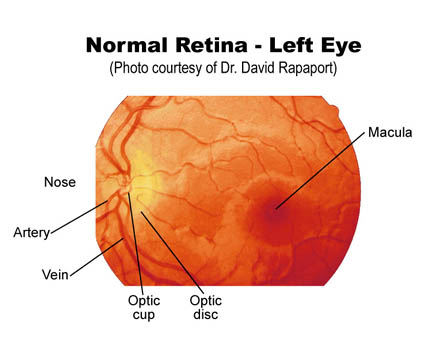
(Picture Courtesy of David Rapaport and Charlie Goldberg)
In order to view the patient's left eye, grasp the scope in your left hand and use your left eye; then repeat the process described above.
If possible, try to avoid eating garlic, onions or other strong smelling food. If you are "dependent" on these substances, invest in a box of tic-tacs for use during the exam!
It is much easier to examine the retina after the pupil has been pharmacologically dilated. In actual practice, however, most providers, with the exception of optometrists and ophthalmologists, do not routinely perform dilated eye exams. This is because dilation takes time and is a bit uncomfortable for the patient as it causes increased light sensitivity that lasts for several hours. Additionally, a non-dilated view of the retina is adequate for a general exam in which the patient has no specific ophthalmologic complaints. Take advantage of any opportunity to perform an examination through a dilated pupil as this is a great way of learning. Make use of additional reference texts, paying particular attention to color photos depicting variants of normal as well as the findings associated with common disease states.
School vision screening
Comprehensive eye examination (A quick reference chart)
Case history
Entrance tests
- External examination
- Visual acuity
- Amplitude of accommodation
- Color vision
- Cover test
- Stereopsis
- Near point of convergence
- Extraocular motilities
- Pupils
- Visual field screening
- Interpupillary distance
Refraction
- Lensometry
- Keratometry
- Retinoscopy
- Refraction
- Monocular
- Binocular balance
- Cycloplegic refraction
Functional tests
- Accommodative system
- Vergence system
Health assessment
- Slit lamp biomicroscopy
- Direct ophthalmoscopy
- Binocular indirect ophthalmoscopy
- Tonometry
- Amsler grid
- Visual field assessment
- Gonioscopy
Advanced techniques
- Corneal topography
- Corneal pachymetry
- Scheimpflug ocular imaging
- Retinal tomography
- Ocular computed tomography
- Scanning laser polarimetry
Corneal Pachymetry
Corneal pachymetry is a measurement of the thickness of the cornea using ultrasound[8]
School vision screening
References
- ↑ Bickley LS. Bates' Guide to Physical Exam and History Taking. 7th edition, Philadelphia; Lippincott 1999: 163-70, 184-95, 211-27.
- ↑ Leibowitz HM. The red eye. NEJM 2000; 343: 345-51.
- ↑ Sapira JD. The Art and Science of Bedside Diagnosis. 1st edition, Baltimore; Williams and Wilkins 1990: 139-53; 155-205.
- ↑ Shingleton BJ, O'Donoghue. Blurred vision. NEJM 2000; 343: 556-62.
- ↑ Shingleton BJ. Eye injuries. NEJM 1991;325: 408-13.
- ↑ Vaughan D, Asbury T, Riordan-Eva P. General ophthalmology. 15th edition, Stamford; Appleton and Lange 1999.
- ↑ Wu G. Ophthalmology for primary care. 1st edition, Philadelphia; W.B. Saunders Company 1997.
- ↑ EyeMDLink